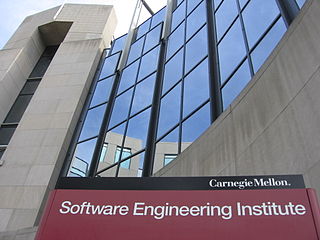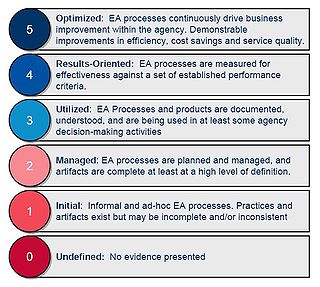The Capability Maturity Model (CMM) is a development model created in 1986 after a study of data collected from organizations that contracted with the U.S. Department of Defense, who funded the research. The term "maturity" relates to the degree of formality and optimization of processes, from ad hoc practices, to formally defined steps, to managed result metrics, to active optimization of the processes.

Software Engineering Institute (SEI) is a federally funded research and development center in Pittsburgh, Pennsylvania, United States. Founded in 1984, the institute is now sponsored by the United States Department of Defense and the Office of the Under Secretary of Defense for Research and Engineering, and administrated by Carnegie Mellon University. The activities of the institute cover cybersecurity, software assurance, software engineering and acquisition, and component capabilities critical to the United States Department of Defense.
ISO/IEC 15504Information technology – Process assessment, also termed Software Process Improvement and Capability dEtermination (SPICE), is a set of technical standards documents for the computer software development process and related business management functions. It is one of the joint International Organization for Standardization (ISO) and International Electrotechnical Commission (IEC) standards, which was developed by the ISO and IEC joint subcommittee, ISO/IEC JTC 1/SC 7.
Capability Maturity Model Integration (CMMI) is a process level improvement training and appraisal program. Administered by the CMMI Institute, a subsidiary of ISACA, it was developed at Carnegie Mellon University (CMU). It is required by many U.S. Government contracts, especially in software development. CMU claims CMMI can be used to guide process improvement across a project, division, or an entire organization.
Quality management ensures that an organization, product or service consistently functions well. It has four main components: quality planning, quality assurance, quality control, and quality improvement. Quality management is focused both on product and service quality and the means to achieve it. Quality management, therefore, uses quality assurance and control of processes as well as products to achieve more consistent quality. Quality control is also part of quality management. What a customer wants and is willing to pay for it, determines quality. It is a written or unwritten commitment to a known or unknown consumer in the market. Quality can be defined as how well the product performs its intended function.
The Capability Maturity Model Integration (CMMI) defines a process area as, "a cluster of related practices in an area that, when implemented collectively, satisfies a set of goals considered important for making improvement in that area." Both CMMI for Development v1.3 and CMMI for Acquisition v1.3 identify 22 process areas, whereas CMMI for Services v1.3 identifies 24 process areas. Many of the process areas are the same in these three models.
Capability Immaturity Model (CIMM) in software engineering is a parody acronym, a semi-serious effort to provide a contrast to the Capability Maturity Model (CMM). The Capability Maturity Model is a five point scale of capability in an organization, ranging from random processes at level 1 to fully defined, managed and optimized processes at level 5. The ability of an organization to carry out its mission on time and within budget is claimed to improve as the CMM level increases.
The implementation maturity model (IMM) is an instrument to help an organization in assessing and determining the degree of maturity of its implementation processes.
A Software Engineering Process Group (SEPG) is an organization's focal point for software process improvement activities. These individuals perform assessments of organizational capability, develop plans to implement needed improvements, coordinate the implementation of those plans, and measure the effectiveness of these efforts. Successful SEPGs require specialized skills and knowledge of many areas outside traditional software engineering.
The Standard CMMI Appraisal Method for Process Improvement (SCAMPI) is the official Software Engineering Institute (SEI) method to provide benchmark-quality ratings relative to Capability Maturity Model Integration (CMMI) models. SCAMPI appraisals are used to identify strengths and weaknesses of current processes, reveal development/acquisition risks, and determine capability and maturity level ratings. They are mostly used either as part of a process improvement program or for rating prospective suppliers. The method defines the appraisal process as consisting of preparation; on-site activities; preliminary observations, findings, and ratings; final reporting; and follow-on activities.
The Trillium Model, created by a collaborative team from Bell Canada, Northern Telecom and Bell Northern Research combines requirements from the ISO 9000 series, the Capability Maturity Model (CMM) for software, and the Baldrige Criteria for Performance ExcellenceArchived 2016-08-04 at the Wayback Machine, with software quality standards from the IEEE. Trillium has a telecommunications orientation and provides customer focus. The practices in the Trillium Model are derived from a benchmarking exercise which focused on all practices that would contribute to an organization's product development and support capability. The Trillium Model covers all aspects of the software development life-cycle, most system and product development and support activities, and a significant number of related marketing activities. Many of the practices described in the model can be applied directly to hardware development.
An independent test organization is an organization, person, or company that tests products, materials, software, etc. according to agreed requirements. The test organization can be affiliated with the government or universities or can be an independent testing laboratory. They are independent because they are not affiliated with the producer nor the user of the item being tested: no commercial bias is present. These "contract testing" facilities are sometimes called "third party" testing or evaluation facilities.
A maturity model is a framework for measuring an organization's maturity, or that of a business function within an organization, with maturity being defined as a measurement of the ability of an organization for continuous improvement in a particular discipline. The higher the maturity, the higher will be the chances that incidents or errors will lead to improvements either in the quality or in the use of the resources of the discipline as implemented by the organization.

The Enterprise Architecture Assessment Framework (EAAF) was created by the US Federal government Office of Management and Budget (OMB) to allow federal agencies to assess and report their enterprise architecture activity and maturity, and advance the use of enterprise architecture in the federal government.

Roger Redmond Bate was a brigadier general, Rhodes Scholar, professor, and scientist who had held a variety of positions with the Air Force, Texas Instruments, and the Software Engineering Institute at Carnegie Mellon University.
In software engineering, a software development process or software development life cycle (SDLC) is a process of planning and managing software development. It typically involves dividing software development work into smaller, parallel, or sequential steps or sub-processes to improve design and/or product management. The methodology may include the pre-definition of specific deliverables and artifacts that are created and completed by a project team to develop or maintain an application.
Automotive SPICE is a maturity model adapted for the automotive industry. It assesses the maturity of development processes for electronic and software-based systems. It is based on an initiative of the Special Interest Group Automotive and the Quality Management Center (QMC) in the German Association of the Automotive Industry (VDA).
The Open Source Maturity Model (OMM) is a methodology for assessing Free/Libre Open Source Software (FLOSS) and more specifically the FLOSS development process. This methodology is released under the Creative Commons license.
Bill Curtis is a software engineer best known for leading the development of the Capability Maturity Model and the People CMM in the Software Engineering Institute at Carnegie Mellon University, and for championing the spread of software process improvement and software measurement globally. In 2007 he was elected a Fellow of the Institute of Electrical and Electronics Engineers (IEEE) for his contributions to software process improvement and measurement. He was named to the 2022 class of ACM Fellows, "for contributions to software process, software measurement, and human factors in software engineering".

Tudor IT Process Assessment (TIPA) is a methodological framework for process assessment. Its first version was published in 2003 by the Public Research Centre Henri Tudor based in Luxembourg. TIPA is now a registered trademark of the Luxembourg Institute of Science and Technology (LIST). TIPA offers a structured approach to determine process capability compared to recognized best practices. TIPA also supports process improvement by providing a gap analysis and proposing improvement recommendations.




